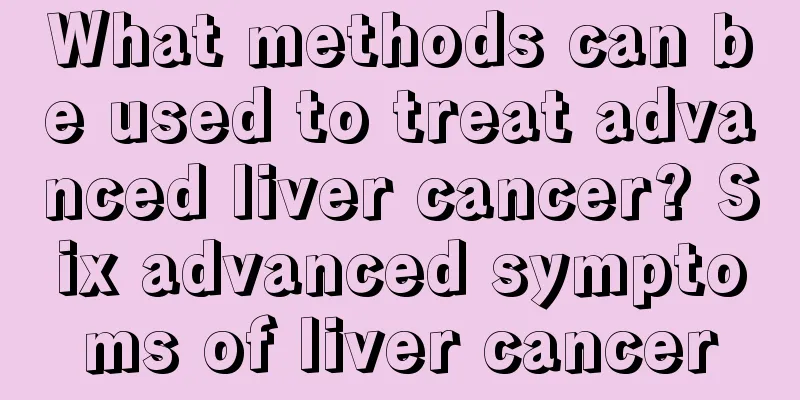What methods can be used to treat advanced liver cancer? Six advanced symptoms of liver cancer

|
Liver cancer is a common malignant tumor, especially when it develops to the late stage, it can be life-threatening at any time. Do you know what treatments are available for late stage liver cancer? Generally speaking, surgery is the first choice for treating liver cancer. In addition, patients can also choose a variety of treatments including radiofrequency ablation, microwave ablation, high-intensity focused ultrasound, intra-arterial chemoembolization, alcohol injection, cryotherapy, radiotherapy, molecular targeted therapy, immunotherapy and traditional Chinese medicine. These methods are mainly used for patients who cannot undergo surgical treatment for various reasons. Here are some common treatment methods for advanced liver cancer. Treatment of advanced liver cancer 1. Surgery The traditional treatment for liver cancer is surgical resection, but not all liver cancer patients are suitable for surgery. Only patients with good cardiopulmonary function, localized liver tumors, and no metastasis are suitable for surgery. The tumor tissue is completely removed through surgery to achieve the purpose of cure. These mainly include liver resection and liver transplantation. 2. Chemotherapy Chemotherapy is the main treatment for advanced liver cancer. It has a relatively direct inhibitory effect on cancer, but it also kills normal cells while killing cancer cells. The most obvious reactions are impaired digestive function and suppressed bone marrow hematopoietic function. 3. Ultrasound ablation therapy Most patients with advanced liver cancer or metastatic liver cancer combined with tumor lesions in other parts of the body no longer have the opportunity for surgery, but they still need to treat local tumors to prolong life and relieve symptoms. Tumor ablation can be considered at this time. 4. Traditional Chinese Medicine Treatment Traditional Chinese medicine has a long history in China, and it is also very effective in treating cancer. If liver cancer is treated with traditional Chinese medicine, the effect is often complementary, which can alleviate the patient's pain as much as possible, and reduce the various toxic side effects of Western medicine alone. 5. Interventional treatment It is also a commonly used method, so what are the limitations of this method? Liver cancer mainly relies on the hepatic artery for blood supply, but there is portal vein blood supply around the cancer mass, so cancer cells can "survive in vain". Even if the operation is carried out superselectively, due to reasons such as high-pressure injection, it may cause accidental thrombosis, shunting and inevitable micro-metastasis; some patients' blood vessels are blocked after one treatment, making it difficult to operate again. Six advanced symptoms of liver cancer 1. Acute abdomen Obvious pain in the liver area is a symptom of liver capsule irritation. After the rupture of cancerous nodules in some patients, acute abdominal pain often occurs, accompanied by symptoms of peritoneal irritation, which can easily be misdiagnosed as acute peritonitis. 2. Lower limb edema Ascites compresses the veins of the lower limbs or the cancer thrombus blocks them, causing venous return obstruction. Clinically, it is common for patients to have severe edema in their lower limbs and for fluid to seep out of the thigh skin. 3. Bleeding tendency This is caused by liver damage and abnormal coagulation function. Liver cancer patients often have bleeding symptoms such as bleeding gums, gastrointestinal bleeding, and subcutaneous ecchymosis. 4. Weight loss and fatigue As the disease worsens, liver function is severely damaged, and the patient suffers from loss of appetite, nausea and vomiting, and nutrient intake and absorption do not meet normal standards, liver cancer patients often become increasingly thinner. 5. Fever Most fevers are low to moderate, and a few patients may have high fever, above 39°C, usually accompanied by chills. The fever of liver cancer is mostly cancer fever, which is caused by the release of pyrogens into the blood circulation after tumor tissue necrosis. 6. Pain in the liver area In the late stage of liver cancer, normal tissues will be destroyed and infiltrated by tumors, causing compression and destruction of nearby nerve roots, ischemic necrosis of local tissues, obstruction of blood return, and infiltration of bones and periosteum, all of which may cause pain. |
<<: How to prevent lung cancer? 5 tips to keep you away from lung cancer
>>: What are the causes of primary liver cancer? Six reasons can lead to primary liver cancer
Recommend
What should I do about loose stools
The problem of loose stools must be treated and r...
What's the matter with a line below the belly button
Some female friends find a line below their belly...
What foods contain iron and protein?
Iron and protein are the most important nutrients...
Analysis of the causes of gastric cancer
As a common malignant tumor in China, the inciden...
What does it mean to bite your tongue in a dream
Dreaming is a common thing, and almost everyone h...
Urine smells like garlic
In people's daily lives, many people have a s...
Does kelp reduce inflammation?
Many people in our daily life like to eat kelp ve...
What's the matter with clear water flowing out of the ears
Human ears are used to hear sounds. If the ears c...
Is sodium bicarbonate thermally stable?
Sodium bicarbonate is what we commonly call bakin...
What should I do if my eyes are extremely itchy due to allergic rhinitis? Several common therapies
People with allergic rhinitis should understand t...
How much does it cost to treat glioma
How much does it cost to treat glioma? There are ...
Abdominal breathing causes a big belly
Abdominal breathing is also a relatively common b...
How to quickly solve the itching in the lower body
Having an itchy lower body is a very embarrassing...
Is throat cancer contagious?
Is throat cancer contagious? Throat cancer is als...
How to prevent hemorrhoids
As the saying goes, "Nine out of ten people ...









